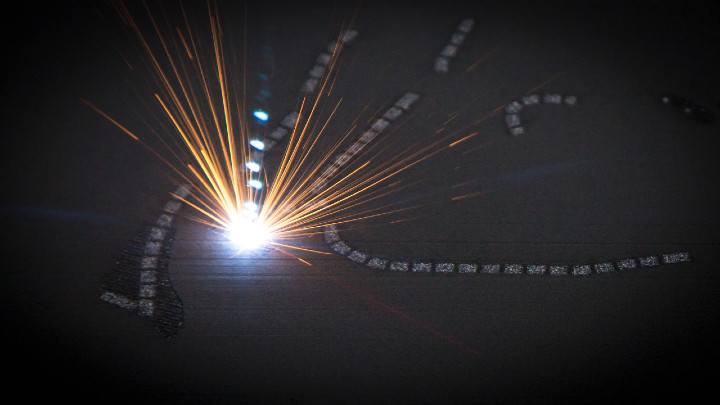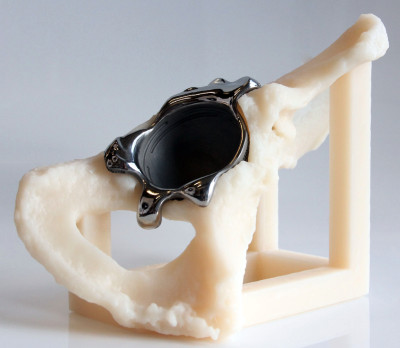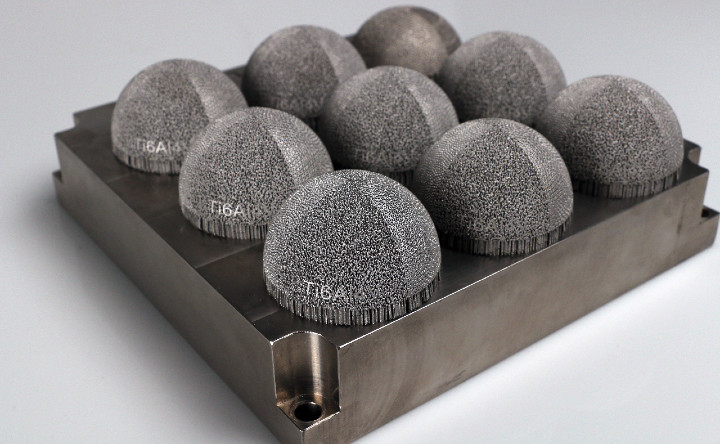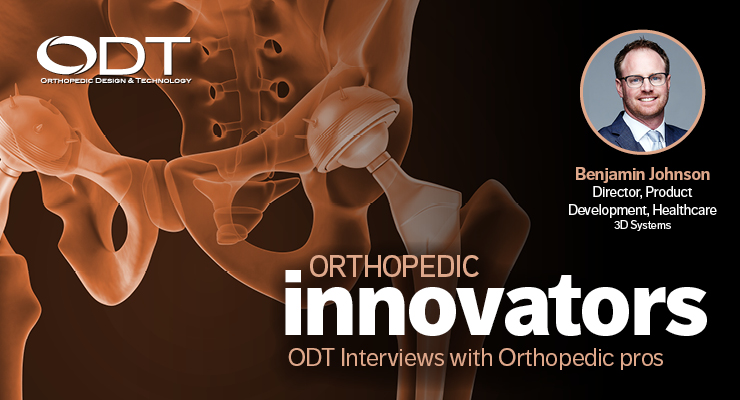By Sean Fenske, Editor-in-Chief
Additive manufacturing, or more specifically, 3D printing has been around for long enough now that certain aspects have reached the stage where it is considered a mature technology. That said, there are still innovations happening quite often. Further, new applications are better suited to 3D printing today that weren’t a fit just a couple years ago.
Within the orthopedic technology space, the opportunity exists (and is already happening) for personalization of implants to each patient. Since a patient’s imaging scans can be leveraged to fabricate a customized, 3D printed implant, the benefits to fit, form, and function are substantially enhanced. With more advancements of the technology as well as the materials used, this practice will only grow and become commonplace.
Benjamin Johnson, director of product development—Healthcare at 3D Systems, took time to speak on these and other topics surrounding the use of 3D printing within the orthopedic space. He offers comments on using the process for production-ready parts, materials, barriers to growth, and more.
Sean Fenske: What are the primary reasons behind the interest in 3D printing for the orthopedic industry?
Benjamin Johnson: The successful penetration of 3D printing into the orthopedic market is driven by the ability of the technology to help improve patient care. Innovations in orthopedic products that leverage 3D printing have enhanced fit, form, and function over their traditionally manufactured counterparts. For example, the freedom of design allowed by 3D printing has resulted in orthopedic products that are more precisely matched to the patient’s anatomy. In addition, bone-contacting implant surfaces can be functionalized with structures that are osteoconductive for better integration of the implant to the patient’s bone. Finally, 3D printing can produce parts without sacrifice to performance or quality of the medical device. The technology is transformative to the industry and a big win for patients and their providers.
Fenske: What considerations should a company keep in mind when looking to use 3D printing for production-ready parts (i.e., beyond prototyping) or even implants?
Johnson: It’s important to keep in mind that 3D printing is deceptively complex as a manufacturing tool for medical devices. The 3D printer doesn’t solve all problems for all parts, but as part of a complete additive manufacturing (AM) solution, it can be a fantastic addition to the set of tools a manufacturer deploys. Some considerations should include the facility requirements, the part and material handling processes, and the scalability of production. Because AM for production parts is still relatively new, the partnership a company has with a solution provider possessing deep expertise and experience becomes critical to ensure successful installation, validation, and onboarding of the technology within a reasonable timeframe.

3D Systems’ DMP platform is engineered to deliver repeatable quality across a variety of medical device applications.
Fenske: Is there a difference validating a 3D printing process compared to another component fabrication process like injection molding or machining?
Johnson: The concept and rationale for AM process validation are no different than any other manufacturing technique. In the end, the process must objectively demonstrate a level of reliability and quality commensurate to the potential risk of process or product failure. Also consistent with other fabrication processes, there are operating conditions and parameters that can impact product quality. Understanding how all the operating conditions and parameters unique to the AM process impact part quality is where experience and know-how can save months to years in product development.
Fenske: What is the status of the materials indicated for 3D printing? Is this aspect currently a limiting factor?
Johnson: There are a wide variety of materials available for 3D printing to address a host of applications across industries. In the early days of 3D printing, materials were developed to meet prototyping or investment casting needs. Today, enhanced focus is placed on developing materials that meet production part needs. There are some limitations to healthcare applications because there isn’t a suitable material available, but I see this as a challenge that the 3D printing community will solve.
Fenske: Price had previously been one of the barriers to the wider use of 3D printing. What’s happened there?
Johnson: To fully address this question, we must first keep in mind that additive manufacturing is not a replacement for traditional manufacturing technologies. When evaluating if AM should be used, it’s important to determine if it is the right solution for the application at hand. The costs associated with AM for production applications are a barrier for some applications but result in cost savings in many other applications. We will continue to see 3D printing as part of a complete AM solution used to solve problems and provide value across the supply chain moving forward. Oftentimes, AM can be used to remove steps and cost from a traditional manufacturing process that results in equivalent product performance. More exciting to me is how the technology can reduce product costs by consolidating assemblies and multiple products into one printed part. Additionally, we believe there are significant total cost of procedure savings to patients treated with a personalized approach through solutions such as 3D Systems’ VSP system and patient-matched instrumentation.
Fenske: As a result of 3D printing and other additive manufacturing techniques, we can customize implants to a patient. What challenges still exist here?

Patient-specific acetabular device
Johnson: While there are several successful patient-matched implant products on the market, there are two primary challenges. First, the design of patient-matched implants needs to conform to an envelope of parameters that are understood and validated to ensure safe and effective products. It is challenging to derive the proper boundary conditions and biomechanical data that informs this design envelope. Second, the production of patient-matched implants needs to be faster. Surgeons need these solutions in hand within a reasonable treatment window timeframe to be of any value to the patient. 3D Systems is working with our partners to address both these issues by developing solutions—comprising materials, software, hardware, and services—to create a more efficient, compliant ecosystem.
Fenske: What’s coming in the realm of 3D printing? What can we expect next year, in five years, and/or in ten years?
Johnson: Without a doubt, 3D printing will continue to penetrate the orthopedic market both in stock and patient-matched products in the near term. Today, there aren’t any orthopedic device manufacturers that haven’t adopted 3D printing as part of their manufacturing workflow. We will continue to see product innovation that captures the advantages of AM for design flexibility and personalization in the next few years. A bit further out, but coming soon are additional materials that meet product requirements in more advanced metallic alloys and high-temperature plastics and the 3D-printing systems that enable much faster turnaround times and better reliability. On the 10 year horizon, I believe AM will be mainstream and used across most of the orthopedic product portfolio. Additionally, we will see 3D-printed products that combine pharmaceuticals and biologics into patient-specific solutions created with inputs from the patient’s pathology and genomics for a truly personalized solution. The one prediction that is assured is the continued use of the technology to help improve patient’s lives.
Fenske: Do you have any additional comments you’d like to share based on any of the topics we discussed?
Johnson: While 3D printing has been a transformative technology for many industries, it has undergone its own transformation as well throughout its 30-plus-years history. From its inception when Chuck Hull invented stereolithography for prototyping, we’ve seen the technology used in a growing number of industries, and we will continue to see new use cases and applications. It is no longer a novel technology at the fringes of healthcare, but a maturing technology that will continue to evolve and grow. It’s exciting to be a part of a company that is driving innovation, and witness the impact being made in healthcare delivery.
Contact 3D Systems >>>>>

3D Systems’ Healthcare additive manufacturing solutions enable highly repeatable quality parts ideal for orthopedic applications.
Additive manufacturing, or more specifically, 3D printing has been around for long enough now that certain aspects have reached the stage where it is considered a mature technology. That said, there are still innovations happening quite often. Further, new applications are better suited to 3D printing today that weren’t a fit just a couple years ago.
Within the orthopedic technology space, the opportunity exists (and is already happening) for personalization of implants to each patient. Since a patient’s imaging scans can be leveraged to fabricate a customized, 3D printed implant, the benefits to fit, form, and function are substantially enhanced. With more advancements of the technology as well as the materials used, this practice will only grow and become commonplace.
Benjamin Johnson, director of product development—Healthcare at 3D Systems, took time to speak on these and other topics surrounding the use of 3D printing within the orthopedic space. He offers comments on using the process for production-ready parts, materials, barriers to growth, and more.
Sean Fenske: What are the primary reasons behind the interest in 3D printing for the orthopedic industry?
Benjamin Johnson: The successful penetration of 3D printing into the orthopedic market is driven by the ability of the technology to help improve patient care. Innovations in orthopedic products that leverage 3D printing have enhanced fit, form, and function over their traditionally manufactured counterparts. For example, the freedom of design allowed by 3D printing has resulted in orthopedic products that are more precisely matched to the patient’s anatomy. In addition, bone-contacting implant surfaces can be functionalized with structures that are osteoconductive for better integration of the implant to the patient’s bone. Finally, 3D printing can produce parts without sacrifice to performance or quality of the medical device. The technology is transformative to the industry and a big win for patients and their providers.
Fenske: What considerations should a company keep in mind when looking to use 3D printing for production-ready parts (i.e., beyond prototyping) or even implants?
Johnson: It’s important to keep in mind that 3D printing is deceptively complex as a manufacturing tool for medical devices. The 3D printer doesn’t solve all problems for all parts, but as part of a complete additive manufacturing (AM) solution, it can be a fantastic addition to the set of tools a manufacturer deploys. Some considerations should include the facility requirements, the part and material handling processes, and the scalability of production. Because AM for production parts is still relatively new, the partnership a company has with a solution provider possessing deep expertise and experience becomes critical to ensure successful installation, validation, and onboarding of the technology within a reasonable timeframe.

3D Systems’ DMP platform is engineered to deliver repeatable quality across a variety of medical device applications.
Fenske: Is there a difference validating a 3D printing process compared to another component fabrication process like injection molding or machining?
Johnson: The concept and rationale for AM process validation are no different than any other manufacturing technique. In the end, the process must objectively demonstrate a level of reliability and quality commensurate to the potential risk of process or product failure. Also consistent with other fabrication processes, there are operating conditions and parameters that can impact product quality. Understanding how all the operating conditions and parameters unique to the AM process impact part quality is where experience and know-how can save months to years in product development.
Fenske: What is the status of the materials indicated for 3D printing? Is this aspect currently a limiting factor?
Johnson: There are a wide variety of materials available for 3D printing to address a host of applications across industries. In the early days of 3D printing, materials were developed to meet prototyping or investment casting needs. Today, enhanced focus is placed on developing materials that meet production part needs. There are some limitations to healthcare applications because there isn’t a suitable material available, but I see this as a challenge that the 3D printing community will solve.
Fenske: Price had previously been one of the barriers to the wider use of 3D printing. What’s happened there?
Johnson: To fully address this question, we must first keep in mind that additive manufacturing is not a replacement for traditional manufacturing technologies. When evaluating if AM should be used, it’s important to determine if it is the right solution for the application at hand. The costs associated with AM for production applications are a barrier for some applications but result in cost savings in many other applications. We will continue to see 3D printing as part of a complete AM solution used to solve problems and provide value across the supply chain moving forward. Oftentimes, AM can be used to remove steps and cost from a traditional manufacturing process that results in equivalent product performance. More exciting to me is how the technology can reduce product costs by consolidating assemblies and multiple products into one printed part. Additionally, we believe there are significant total cost of procedure savings to patients treated with a personalized approach through solutions such as 3D Systems’ VSP system and patient-matched instrumentation.
Fenske: As a result of 3D printing and other additive manufacturing techniques, we can customize implants to a patient. What challenges still exist here?

Patient-specific acetabular device
Fenske: What’s coming in the realm of 3D printing? What can we expect next year, in five years, and/or in ten years?
Johnson: Without a doubt, 3D printing will continue to penetrate the orthopedic market both in stock and patient-matched products in the near term. Today, there aren’t any orthopedic device manufacturers that haven’t adopted 3D printing as part of their manufacturing workflow. We will continue to see product innovation that captures the advantages of AM for design flexibility and personalization in the next few years. A bit further out, but coming soon are additional materials that meet product requirements in more advanced metallic alloys and high-temperature plastics and the 3D-printing systems that enable much faster turnaround times and better reliability. On the 10 year horizon, I believe AM will be mainstream and used across most of the orthopedic product portfolio. Additionally, we will see 3D-printed products that combine pharmaceuticals and biologics into patient-specific solutions created with inputs from the patient’s pathology and genomics for a truly personalized solution. The one prediction that is assured is the continued use of the technology to help improve patient’s lives.
Fenske: Do you have any additional comments you’d like to share based on any of the topics we discussed?
Johnson: While 3D printing has been a transformative technology for many industries, it has undergone its own transformation as well throughout its 30-plus-years history. From its inception when Chuck Hull invented stereolithography for prototyping, we’ve seen the technology used in a growing number of industries, and we will continue to see new use cases and applications. It is no longer a novel technology at the fringes of healthcare, but a maturing technology that will continue to evolve and grow. It’s exciting to be a part of a company that is driving innovation, and witness the impact being made in healthcare delivery.
Contact 3D Systems >>>>>

3D Systems’ Healthcare additive manufacturing solutions enable highly repeatable quality parts ideal for orthopedic applications.














